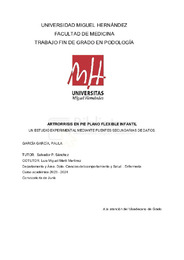Resumen :
Introducción: La artrorrisis es una técnica quirúrgica para el tratamiento del pie plano infantil. El pie plano es una de las patologías más comunes de pie y tobillo. El pie plano es multifactorial y se caracteriza por presentar el calcáneo en valgo, posición medial-plantar del astrágalo y reducción o ausencia del arco longitudinal interno. A su vez, puede ser flexible o rígido. Objetivos: Analizar la eficacia de la artrorrisis en niños con retropié valgo y antepié abducido. Métodos: Se analizaron 9 ensayos clínicos con un total de 251 pacientes de entre 5 y 15 años. Se compararon los datos clínicos pre y postoperatorios, incluyendo ángulos radiográficos, dolor, complicaciones y funcionalidad del pie. Resultados: Los estudios evaluaron los ángulos TNCA, Meary, Kite AP, inclinación del calcáneo, Kite lateral y Costa Bartani. En la mayoría de los estudios, todos los ángulos mejoraron significativamente después de la artrorrisis. La funcionalidad del pie mejoró significativamente en todos los estudios, según la escala AOFAS. Discusión: La artrorrisis es una técnica eficaz para el tratamiento del pie plano valgo infantil sintomático, con una mejora significativa de los ángulos radiográficos, la funcionalidad del pie y un bajo riesgo de complicaciones. El dolor en el seno del tarso es la complicación más común. Corrección completa del valgo de retropié en el 55,97% de los pacientes y disminución considerable del valgo de retropié quedando cerca de la neutralidad en el 44,02% de los pacientes. Conclusiones: La artrorrisis es una técnica eficaz para el tratamiento del retropié valgo y antepié abducido en niños, con una mejora significativa de los ángulos radiográficos, la funcionalidad del pie y un bajo riesgo de complicaciones.
Introduction:The arthroereisis is a surgical technique to treat childhood flatfoot. The flatfoot is one of the most common pathologies related to foot and ankle. It is also multifactorial, characterized for presenting calcaneous in valgus, medial plantar position of the talus and reduction or absence of the ALI. At the same time it can be flexible or rigid. Objectives: Analyzing the effectiveness of the arthroereisis in children with valgus hindfoot and abducted forefoot. Methodology: Nine clinical trials were analyzed with the participation of 251 children among 5-15 years old. The clinical data were compared during the pre- and - post operative periods, including radiographic angles, pain, complications and foot functionality. Results: The studies evaluated the angles TNCA Kite lateral, Meary, calcaneal inclination, Kite AP and Costa Bærtani. Most of the studies, all the angles improved significantly after the arthroereisis. The functionality of the foot also improved in all the studies, according to the AOFAS scale. Discussion: The arthroereisis is an efficient technique for the treatment of the childhood, valgus, symptomatic flatfoot, with advances in the radiographic angles, the functionality of the foot and a decrease in complications. The pain in senus tarsus is the most common complication. Complete correction of valgus hindfoot in the 55,97% of the patients and a considerable decrease of the hindfoot being closed to the neutrality in the 44,02% of the patients. Conclusion: Arthroereisis is an efficient technique to treat valgus hindfoot and abducted forefoot, with a significant improvement in the radiographic angles, the functionality of the foot and a low risk of complications.
|
 La licencia se describe como: Atribución-NonComercial-NoDerivada 4.0 Internacional.
La licencia se describe como: Atribución-NonComercial-NoDerivada 4.0 Internacional.
.png)
